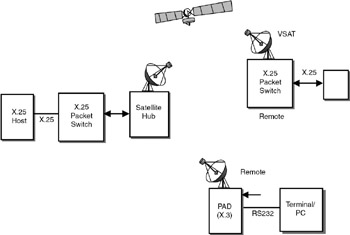18.3 A SATELLITE-BASED X.25 NETWORK
|
| < Day Day Up > |
|
18.3 A SATELLITE-BASED X.25 NETWORK
X.25 is used extensively in satellite-based wide area networks. The typical architecture of the network is shown in Figure 18.4. At the satellite hub (central station), there will be a packet switch (DCE) to which an X.25 host is connected.

Figure 18.4: Satellite-based X.25 wide area network.
A PC add-on card plugged into the server makes the server an X.25 host. At the remotes, there are two possible configurations. Some remotes can have X.25 packet switches, which are connected to X.25 hosts. At other remotes, a special device called a packet assembler/disassembler (PAD) is used. This PAD, as the name suggests, takes the data from a terminal/PC, assembles the packets in the X.25 format, and sends it over the satellite link. The packets received from the satellite are disassembled and given to the terminal/PC. Communication between the PAD and the terminal/PC is through RS232. Two other standards are specified for this configuration. The X.3 standard specifies the parameters of the PAD. The X.28 standard specifies the protocol used by the terminal/PC to communicate with the PAD. The PAD parameters such as the speed of communication, number of data bits, and so on can be set by the terminal/PC.
When a remote terminal wants to communicate with another remote, a virtual circuit is established between the two terminals. The source sends the packets in X.25 format, and the packet switch at the hub switches the packet to the appropriate destination. In such a case, the X.25 host at the hub does not play any role. Some data has to be broadcast to all the VSAT terminals, then the host is required. The host will use the broadcast address to send the packets over the satellite link, and all the remotes will receive it.
Data terminals such as PCs can be connected to the X.25 network through a packet assembler/disassembler (PAD). The PAD takes the data from the PC and assembles the packets in X.25 format to send them over the network.
| Note | The PAD parameters are specified in ITU-T Recommendation X.3. Recommendation X.28 specifies the protocol used by the PC to communicate with the PAD. |
|
| < Day Day Up > |
|
EAN: 2147483647
Pages: 313